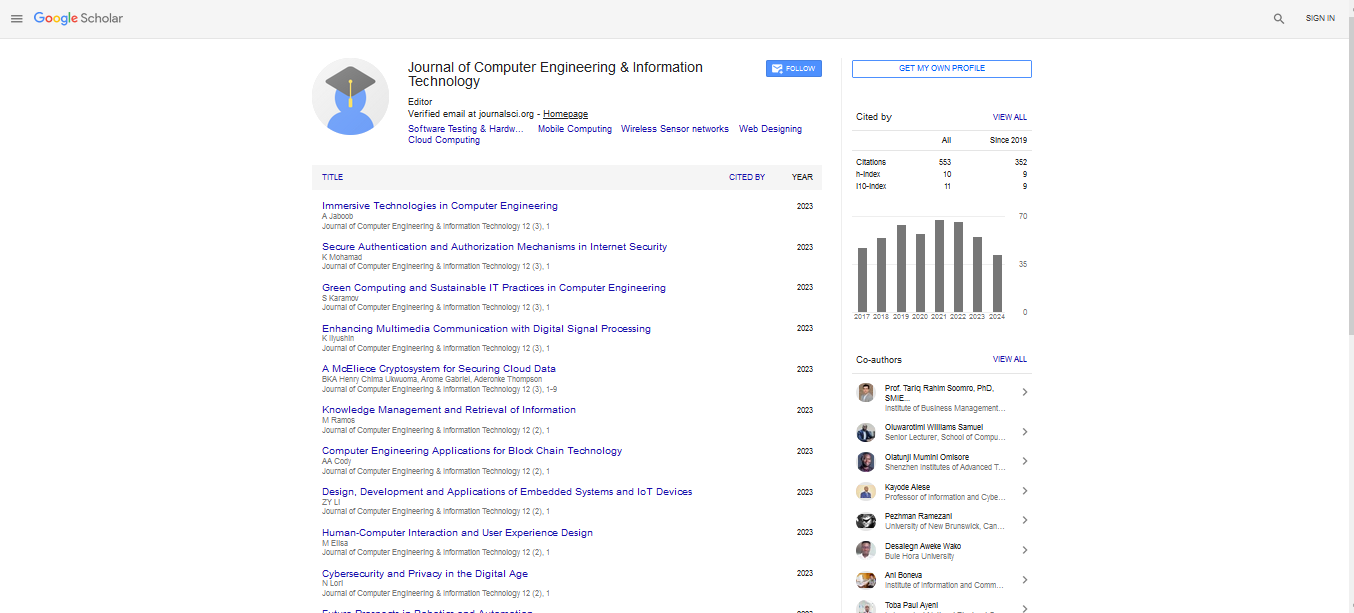Commentary, J Comput Eng Inf Technol Vol: 13 Issue: 6
Block Chain Integration in Wireless Sensor Networks for Secure IoT Communication
Aryan Vagan*
1Department of Artificial Intelligence, Central University of Himachal Pradesh, Dharamshala, India
*Corresponding Author: Aryan Vagan,
Department of Artificial Intelligence,
Central University of Himachal Pradesh, Dharamshala, India
E-mail: aryan.vagan@gmail.com
Received date: 27 October, 2024, Manuscript No. JCEIT-24-151678;
Editor assigned date: 29 October, 2024, PreQC No. JCEIT-24-151678 (PQ);
Reviewed date: 13 November, 2024, QC No. JCEIT-24-151678;
Revised date: 21 November, 2024, Manuscript No. JCEIT-24-151678 (R);
Published date: 29 November, 2024, DOI: 10.4172/2324-9307.1000325
Citation: Vagan A (2024) Block Chain Integration in Wireless Sensor Networks for Secure IoT Communication. J Comput Eng Inf Technol 13:6
Description
The integration of block chain technology into Wireless Sensor Networks (WSNs) is revolutionizing how data security and integrity are managed in the Internet of Things (IoT) landscape. As IoT systems become more pervasive, WSNs are increasingly deployed to collect, analyze and transmit grave data from various environments, including smart cities, healthcare, agriculture and industrial automation. However, this expansive data flow and the distributed nature of WSNs make them vulnerable to security risks like data tampering, unauthorized access and cyber-attacks. Block chain, with its decentralized, tamper-resistant structure, offers a robust solution for securing these networks, ensuring secure data transfer and reliable communication across the IoT ecosystem. This paper discuss how block chain can be effectively integrated with WSNs to enhance security and data integrity, examines key challenges and outlines the potential applications and benefits of this innovative approach.
WSNs consist of spatially distributed sensor nodes that capture data from their surroundings and communicate this information to a central system. In IoT applications, WSNs act as the foundational layer that gathers data in real-time, forming the basis for smart devices to make autonomous decisions, trigger alerts, or provide insights to users. These networks support applications ranging from remote health monitoring to smart homes and industrial equipment tracking. However, WSNs are often limited in processing power, memory and energy. Additionally, because sensor nodes communicate wirelessly and may be deployed in remote locations, they are highly susceptible to various security vulnerabilities. Data transmitted by WSNs can be intercepted, modified, or even destroyed by malicious actors. Traditional centralized security methods are often inefficient for WSNs due to the network’s decentralized nature and the limited capabilities of sensor nodes. Block chain addresses these challenges by providing decentralized security and enabling trustless interactions, making it an attractive solution for enhancing WSN security in IoT applications. Block chain is a decentralized and distributed ledger technology that records transactions across a network of computers. Each transaction is grouped in a block, linked in chronological order, and validated by network participants through consensus mechanisms like Proof of Work (PoW) or Proof of Stake (PoS). This structure ensures that data once written to the block chain cannot be altered without consensus, making it highly secure and tamper-resistant. In a block chain-enabled WSN, each sensor node can act as a light client or lightweight block chain node, responsible for gathering data and transmitting it to more powerful nodes, known as full nodes.
Full nodes validate and add transactions to the block chain and typically require higher computational resources. To manage resources effectively, not all sensor nodes need to participate in consensus; instead, a subset of nodes can perform validation based on their processing power and availability. Consensus mechanisms play a vital role in ensuring data consistency across the block chain network. In WSNs, energy-efficient consensus mechanisms like Proof of Authority (PoA) or Delegated Proof of Stake (DPoS) are often preferred over more resource-intensive methods like PoW. These mechanisms enable the network to reach agreement on transaction validity without exhausting the limited resources of sensor nodes. Smart contracts can facilitate secure and automated interactions between WSN nodes. For instance, a smart contract can automatically verify sensor data’s authenticity and trigger specific actions if the data meets predefined criteria. In agricultural IoT applications, for example, a smart contract could monitor soil moisture levels and automatically initiate irrigation if levels fall below a threshold. This automation reduces the need for manual intervention, enhances efficiency and improves security by eliminating intermediaries.
To minimize latency and improve data processing efficiency, block chain-enabled WSNs often incorporate edge computing. Edge devices, positioned closer to sensor nodes, perform preliminary data processing, which reduces the amount of information sent to the block chain. This approach enhances the scalability of the network and reduces strain on the block chain, especially for real-time applications. The integration of block chain technology with WSNs brings several benefits that strengthen the security, scalability and reliability of IoT communication. Block chain’s decentralized structure secures data against unauthorized access and tampering. Since each block is cryptographically linked to the previous block, any alteration to a single block would require consensus from a majority of nodes, making it almost impossible to change recorded data. This level of security is particularly valuable in applications like healthcare monitoring, where data integrity is grave.
 Spanish
Spanish  Chinese
Chinese  Russian
Russian  German
German  French
French  Japanese
Japanese  Portuguese
Portuguese  Hindi
Hindi 